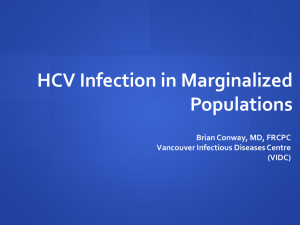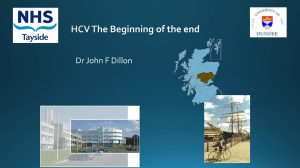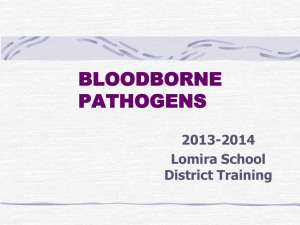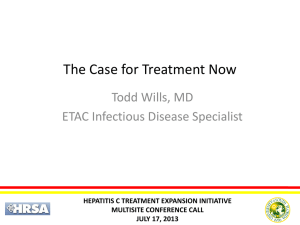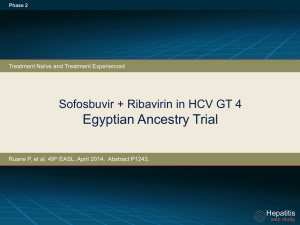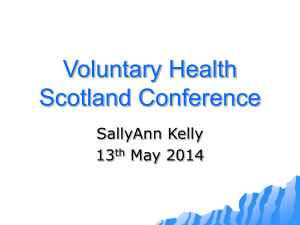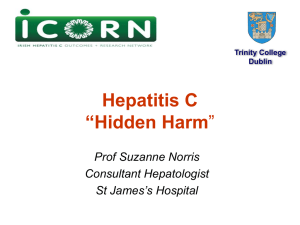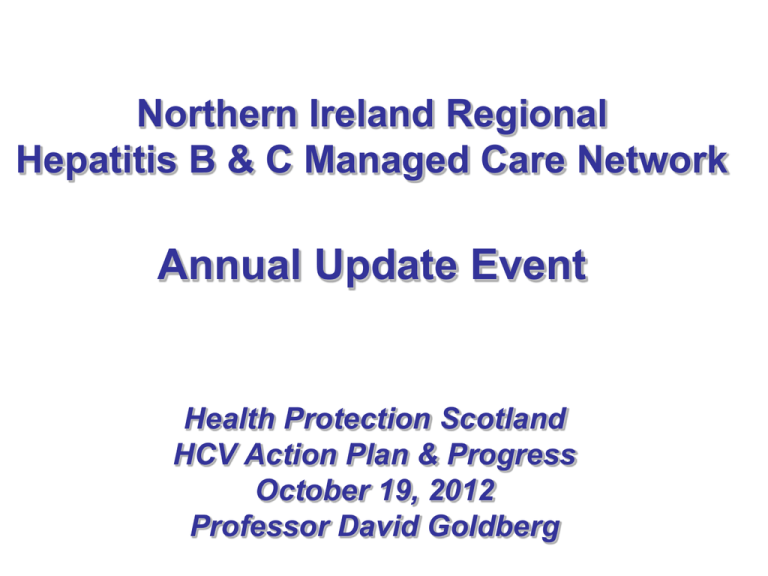
Northern Ireland Regional
Hepatitis B & C Managed Care Network
Annual Update Event
Health Protection Scotland
HCV Action Plan & Progress
October 19, 2012
Professor David Goldberg
The Sexual Health and Blood
Borne Virus Framework
(Sexual Health, HIV, Hepatitis C and Hepatitis B)
Previous Policy
• Sexual Health
– Respect and Responsibility (end Mar 11)
• HIV
– HIV Action Plan (2009 – 2014)
• Hepatitis C
– Hepatitis C Action Plan Phase II (end Mar 11)
• Hepatitis B
– No existing policy other than vaccination
– Acknowledged requirement to establish the landscape of Hep
B in Scotland; consider and implement proposals to begin to
address current and future disease burden
Framework Outcomes
1. Fewer newly acquired blood borne virus and sexually
transmitted infections; fewer unintended pregnancies
2. A reduction in the health inequalities gap in sexual
health and blood borne viruses
3. People affected by blood borne viruses lead longer,
healthier lives
4. Sexual relationships are free from coercion and harm
5. A society whereby the attitudes of individuals, the
public, professionals and the media in Scotland
towards sexual health and blood borne viruses are
positive, non-stigmatising and supportive
Framework Governance
Sexual Health and BBV Framework
Ministerial Advisory Committee
Sexual Health and BBV Framework
Executive Leads Network (Governance Board)
Scottish Government
Sexual Health and BBV Team
National Sexual Health and BBV
Monitoring and Assurance Group
(encompassing HPS/ISD co-Chairs)
(encompassing National Coordinators)
Scottish
Government
meetings/visits
Lead Organisations
Eg. NHS Boards, SPS, NES..
KEY
Accountability
Advice, expertise, best practice
Reporting/data provision to monitor
outcomes & indicators
National Networks
via Network chairs
Hepatitis C Action Plan for Scotland:
Aims
•To prevent the spread of Hepatitis C,
particularly among IDUs.
•To diagnose Hepatitis C infected persons,
particularly those who would most benefit
from treatment.
•To ensure that those infected receive
optimal treatment, care and support.
Hepatitis C Action Plan for Scotland
Phase I: Sept 2006-March 2008 (41 Actions)
•Gathering evidence to inform Phase II
Actions
•Generating Phase II Actions and the
Phase II Action Plan
Hepatitis C epidemiological landscape (estimates): Scotland 2006
People with chronic infection
HCV infection and disease trends
New cases of HCV-related liver failure
in Scotland
Annual number of deaths related to
HCV and AIDS in Scotland
Number of hospital bed-days associated
with HCV-related liver failure in Scotland
HCV prevalence among IDUs <25 years
in Glasgow
Modelled number of IDUs in Scotland developing liver failure
Annual number of liver failures
each year with different uptake rates of HCV antiviral therapy, 2008-2030
150
100
Uptake of HCV antiviral therapy:
225 IDUs per year
50
1,000 IDUs per year
2000 IDUs per year
0
2010
2015
2020
2025
2030
Increasing uptake of therapy to 2,000 per year (2008-2030) will
prevent approx. 5,200 cirrhosis cases (including 2,700 liver failures)
Hepatitis C Action Plan for Scotland
Phase II
• Launched: May 2008 by Health Minister
• 34 Actions
• All Actions to develop/improve services:
Prevention
Diagnosis
Treatment/Care
Hepatitis C Action Plan: Phase II 2008-2011
Principles and Characteristics
The Plan :
• is based on an extensive evidence base and
consultation process
• is a high level one
• embraces all service needs
• adopts a multidisciplinary approach
• covers all geographical areas and settings
• is performance managed
• addresses inequalities
• is supported by serious investment
Scottish Hepatitis C Action Plan: Phase II 2008-2011
Government Investment (£million)
Year 1
Year 2
Year 3
Total
Testing, treatment, care
and support
3.3
10.5
16.3
30.1
Prevention
0.9
3.7
3.6
8.2
Information Generating
Initiatives
0.8
1.5
1.0
3.3
Co-ordination
0.6
0.5
0.5
1.6
Total
5.6
16.2
21.4
43.2
Key Actions & Achievements as at 2011
Prevention
Action :
Major improvements in Injection Equipment provision for IDUs (esp.
paraphernalia)
Impact :
Early signs that incidence of infection falling
Diagnosis
Action :
Awareness raising initiatives
Introduction of finger-prick sampling in non-clinical settings
Impact :
One-third increase in numbers diagnosed over 2-3 years
Treatment/Care
Action :
Managed Care Networks
Increase in clinical capacity
Measures to support patients through clinical pathway
National procurement of antiviral therapy
Impact :
Doubling numbers initiated onto treatment over 2 years
Prevention: Prevalence & incidence of HCV among
IDUs surveyed in mainland Scotland during 2008/09
All IDUs
N=2,516
HCV Ab+ve
HCV Ab-ve
N=1,373 (55%)
N=1,143 (45%)
Avidity testing
HCV PCR+ve
underway
N= 21/1115 (2%)
HCV prevalence
60%
50-59%
HCV incidence
40-49%
10-15/100 pyrs
30-39%
<30%
Trends in recent HCV infection among PWID
in Scotland, 2008 – 2011
(A)
(B)
(C)
% PCR+
HCV incidence per
100 person years*
Number of new HCV
infections per year*
(among HCV Ab- PWID)
4%
χ2
20
(among HCV Ab- PWID)
2,000
(among HCV Ab- PWID)
test for trend
p=0.02
3%
15
1,500
2%
10
1,000
1%
5
500
0%
0
0
2008-9
2010
2011
(N=1140) (1319) (1027)
2008-9
2010
2011
* With 51 day pre-seroconversion
window (Page-Shafer 2008)
2008-9
2010
2011
* Assumes the number of PWID
(N=24,000) remains stable
Key Actions & Achievements as at 2011
Prevention
Action :
Major improvements in Injection Equipment provision for IDUs (esp
paraphernalia)
Impact :
Early signs that incidence of infection falling
Action :
Diagnosis
Awareness raising initiatives
Introduction of finger-prick sampling in non-clinical settings
Impact :
One-third increase in numbers diagnosed over 2 years
Action :
Impact :
Treatment/Care
Managed Care Networks
Increase in clinical capacity
Measures to support patients through clinical pathway
National procurement of antiviral therapy
Doubling numbers initiated onto treatment over 2 years
Number of people diagnosed with HCV in
Scotland, 1991-2011
In 2011
2,147 new diagnoses
2,000
1,500
20,000
1,000
31,468 diagnosed by end 2011
~27,000 diagnosed and living
by end of 2011
10,000
500
0
~50% of people living with
HCV remain undiagnosed
0
1991 1995
2000
2005
Year of diagnosis
2010
Cumulative
Total
30,000
Annual
19% diagnosed in specialist
drug services (DBS testing
introduced in 2009)
Key Actions & Achievements as at 2011
Action :
Prevention
Major improvements in Injection Equipment provision for IDUs (esp
paraphernalia)
Impact :
Early signs that incidence of infection falling
Action :
Diagnosis
Awareness raising initiatives
Introduction of finger-prick sampling in non-clinical settings
Impact :
One-third increase in numbers diagnosed over 2 years
Action :
Impact :
Treatment/Care
Managed Care Networks
Increase in clinical capacity
Measures to support patients through clinical pathway
National procurement of antiviral therapy
Doubling numbers initiated onto treatment over 2 years
Annual number of people initiated on HCV antiviral
therapy in Scotland
Actual number (prison inmates)
468 (17)
2007/08
Scottish Government target
591
2008/09
500
904
2009/10
750
1049 (143)
2010/11
1000
1002
2011/12
1100
0
500
1,000
Number of treatment initiations
8-fold increase
in the number of
prison inmates
treated between
2007/08 and
2010/11
Number of people initiated on HCV antiviral therapy, with
a reported risk factor (data from 16/18 clinics)
Number of treatment initiations (N)
Treated and with a reported risk factor for infection*
Treated and reported IDU
Treated and reported IDU and aged <35 years
N=1071
(100%)
1,000
800
N=572
(100%)
600
400
200
(65%)
N=358
(100%)
N=249
(100%)
(75%)
N=714
(100%)
(63%)
(26%)
(61%)
(58%)
(18%)
(13%)
(17%)
(21%)
0
2000 & 2001
2002 & 2003
2004 & 2005
2006 & 2007
2008 & 2009
Calendar year of treatment initiation
* Proportion with risk factor: 85% in 2000-01; 86% in 2002-03; 87% in 2004-05; 86% in 2006-07; and 81% in 2008-09.
SVR rates by genotype among patients from Scotland1
(initiated 2000-2007), and published RCTs2-4
Genotype 1
Genotype 2/3
80
80
70
70
SVR
(%)
50
72
67
51
46
40
39
RCTs
36
All
PWID
(N=315)
(N=176)
PWID
<35 yrs*
(N=39)
SCOTLAND
RCTs
All
PWID
(N=594)
(N=323)
PWID
<35 yrs*
(N=96)
SCOTLAND
1. Innes et al. Eur J Gastro Hep (in press) 2. Hadziyannis et al. Ann Intern Med, 2004. 3. Manns et al. Lancet, 2001. 4. Fried et al. NEJM, 2002.
PWID: Ever-IDU * SVR rate among all patients aged <35yrs: genotype 1 was 54% (35/65); genotype 2/3 was 76% (121/159).
Excess risk of a liver and an alcohol related hospital episode post
treatment (in SVR & non-SVR patients) AND post diagnosis (in
spontaneously resolved patients), compared to the general population
50.0
53.2
Excess risk*
26.8
10.0
5.0
Liver
10.5
5.9
4.5
2.0
1.0
7.4
Alcohol
1.3
0.5
Non-SVR
(N=638)
* Age, sex & year standardised
SVR
(N=560)
Non-cirrhotic
SVR
(N=503)
Spontaneously
resolved
(N=3,690)
Innes et al. Hepatology, 2011.
Summary 1
• The foundations have been laid: coordination
including networks.
• Considerable progress on treatment front.
• Positive signs that progress is being made in
identifying infected persons.
• Early indications that paraphernalia provision
may be having a considerable impact.
Summary 2
• On reflection four key elements to securing the plan
: Advocacy via patient representative groups
: Epidemiological data
: Clinical leadership
: Therapeutic developments
• On reflection three key elements to sustaining the
plan and making it successful
: Strong governance
: Programme Management approach
: Adequate funding
• Phase III including the incorporation of Hepatitis B
underway.



